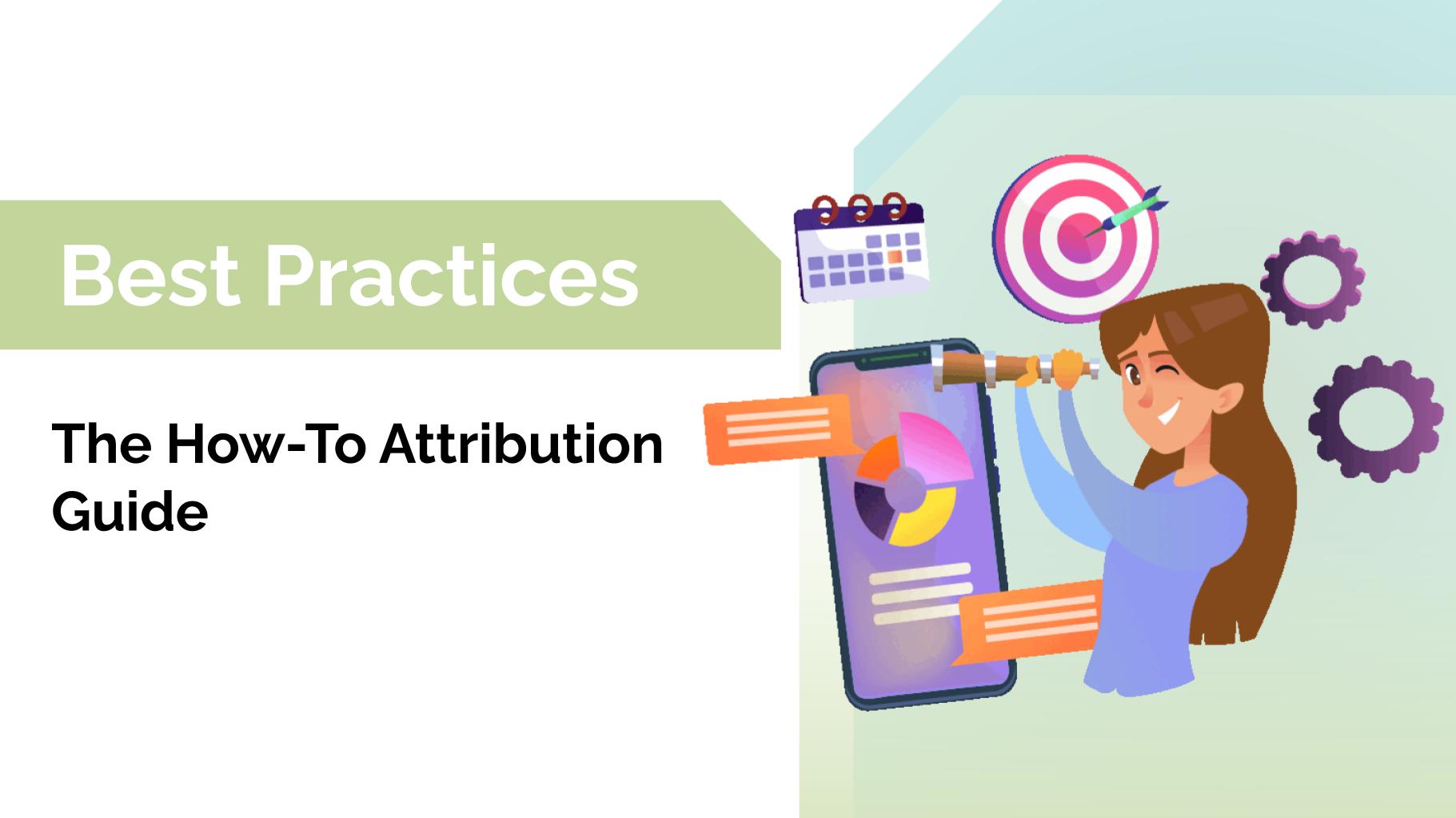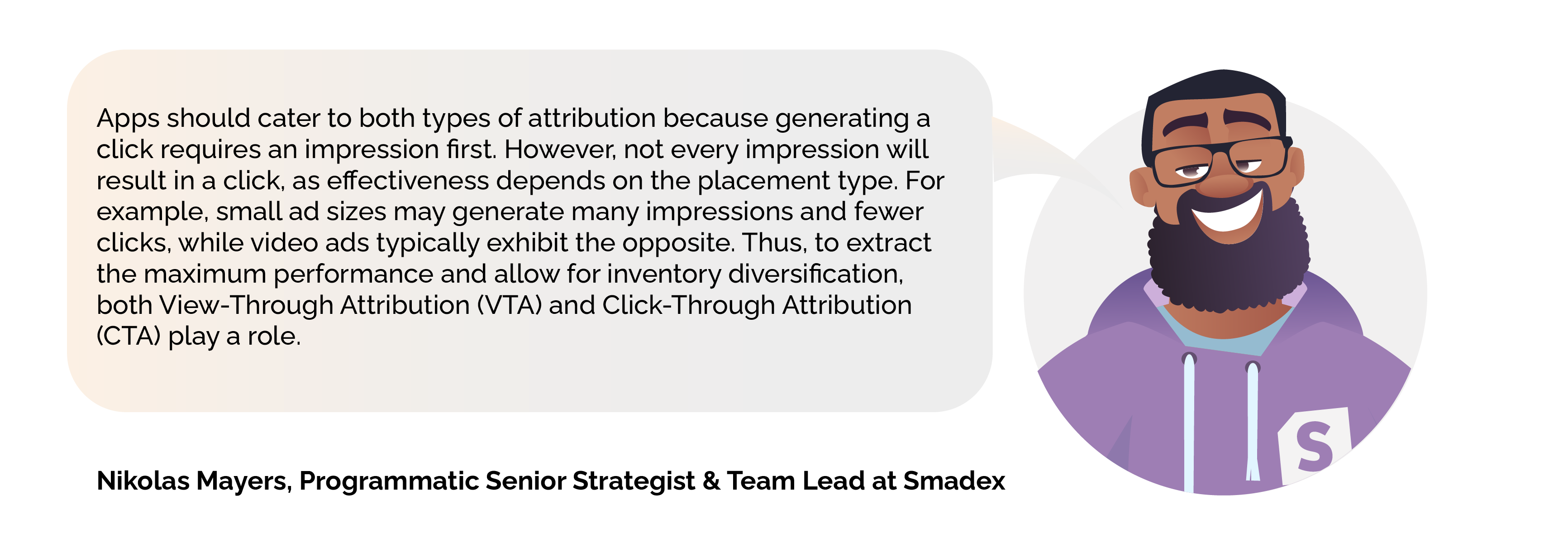In the mobile app realm, attribution is essential for determining whether campaigns work. It’s all about figuring out where users are coming from and what they’re doing in the app, like completing a registration, making an in-app purchase, or reaching a certain level within a game.
Attribution can be applied to almost every digital approach, like mobile, CTV (Connected TV), web, and more. This guide will dive 100% into the mobile app world, covering what it is, its importance, and the different models. We’ll also delve into VTA (view-through attribution) and CTA (click-through attribution) while explaining the differences between deterministic and probabilistic attribution.
If you are interested in CTV Attribution, feel free to read our blog article: Understanding CTV Attribution: How does it work?
Mobile Attribution Basics
What is Mobile Attribution and How Does it Work?
Mobile attribution tracks how different marketing channels impact user actions in an app. It starts by registering interactions with ads, like clicks or views. When users install or take actions within the app, attribution tools match these actions to their previous ad interactions. Different models can help determine how to credit each ad. This data helps marketers identify which ads work best, adjust strategies, and spend the budget more effectively afterward.

Why is Mobile Attribution a Must?
Determining the success of advertising campaigns is essential, and without attribution, we wouldn’t know how ads perform. Tracking user events and understanding how those users behave when faced with paid activity, apps, and ads can improve almost every aspect, including creatives and ad spending.
Why is Mobile Attribution Challenging?
Attribution comes with challenges, such as lack of industry standards, competing models, cross-platform user journeys, and fraud risks.
Collaborating with partners like Smadex, with advanced tracking technology and fraud detection capabilities, apps can effectively address these challenges, ensuring more accurate and a clearer understanding of user behavior.
MMPs Partners
What is an MMP?
An MMP, or Mobile Measurement Partner, is a company that tracks and analyzes user interactions with mobile ads. It provides detailed insights into which ads drive app installs and user engagement.
MMPs Integration
Smadex integrates with the MMPs to streamline tracking. We send them impressions and clicks, and they provide feedback on installs and user activity attributed to our ads afterward. So, what information can we also get from MMPs?
- Non-Attributed Installs: When we get data from the MMP (Mobile Measurement Partner), it includes information about app installs and other actions.
- Non-Attributed Data: This includes all the app activities, whether or not we were credited for them. For example, if someone installs the app or makes a purchase, but we weren’t recognized for that action, it still shows up here.
- Assisted Installs: These are installs where we played a role, like showing an ad or getting a user to click, but we weren’t credited for the install.
- Post-Install Events: We can also see what happens after someone installs the app, including purchases, sign-ups, reaching certain app levels, and in-app purchases.
- Cohorted Data: We also receive data on how well our ads are performing based on the amount of money spent and the revenue generated, which helps us improve our ad strategies. For example, a group of people who share something in common, like the date they installed the app.
Attribution Workflow

Deepen into Attribution
Attribution Models
First-Touch Attribution credits the initial touchpoint that led users to an app, helping identify effective engagement channels and understanding longer paths for large purchases.

Last-Touch Attribution assigns full credit to the last touchpoint before a user converts. Identifying effective channels for driving conversions is simple, but it overlooks the influence of other touchpoints and post-conversion interactions.

Multi-Touch Attribution assigns credit to multiple events along a path to conversion. It tracks user interactions to optimize marketing strategies and budget allocation.

View-Through Attribution vs. Click-Through Attribution

View-Through Attribution (VTA)
View-through attribution, or VTA, is the framework for measuring impressions that lead to installs or impressions that play a role in an install. There is often a gap between when users view an ad and when they install an app.
With VTA, we can get the full picture of a particular ad or campaign’s impact in leading a user to install, gain full visibility, and see which impressions drive installs and engagements.
Click-Through Attribution (CTA)
Click-through attribution tracks installs, engagement, and re-engagement after a user clicks an ad, providing a clear and direct attribution between the click and the resulting action. This method is fast, accurate, and doesn’t require a measurement window for attribution.
Attribution Window: What is it?
When discussing VTA (View Through Attribution) and CTA (Click Through Attribution), it’s important to understand the attribution window. This is a specific time period during which a click or impression is counted as leading to an app install. For the attribution to be valid, the user needs to open the app after installing it.
We should highlight that a click always wins over an impression regarding the last touch. This means that it doesn’t matter if we are still inside the impression window; if there is a click, the install will always be attributed to the channel with the click.
It might sound complex, so let’s explain it using some scenarios. We will work with a 24-hour impression window and a 7-day click window for these.
Scenario 1
Imagine you see an ad on Channel A but don’t click on it. Later, you see another ad for the same app on Channel B; this time, you click the ad and install the app. Seven hours after downloading it, you open the app for the first time. In this case, as the click always wins, no matter if we are still in the impression window, the install will be attributed to Channel B (as we are also inside the 7-day click window).

Scenario 2
This is the same example, but this time, you view the ad on Channel B but don’t click on it. Then, you download the app and open it seven hours after installing it. In this case, as there was no click, the install will be attributed to the last impression, channel B, as we are still in the impression 24-hour window.

Scenario 3
The same example applies, but in this case, you open the app 18 days after installing it. In this case, the install will not be attributed to any channel as both windows (24-hour impression window and 7-day click window) have expired.

Probabilistic vs. Deterministic
Let’s add a little difficulty in introducing these new terms: Probabilistic and Deterministic.
| Aspect | Deterministic Attribution | Probabilistic Attribution |
|---|---|---|
| Tracking Method | Uses specific data like device IDs and user logins. | Relies on aggregated data and statistical models. |
| Data Accuracy | High precision in tracking ad exposure to user actions. | Less precise, based on patterns and probabilities. |
| Data Requirements | Requires accurate and specific user data. | Useful when accurate data is difficult to obtain. |
| Contribution | Offers detailed, accurate information for precise strategies. | Helps in broader, pattern-based strategy optimization. |
| Challenges | Depends on access to user-specific data, which may not always be available. | May lack the precision needed for highly targeted campaigns. |
We should also highlight that deterministic always wins over probabilistic. This means it doesn’t matter if we are still inside the window for both cases; if there is a click-in channel with a deterministic attribution type, the install will always be attributed to that channel (it’s always inside the click attribution window).
Things get a bit more complex as we keep diving into new topics. Let’s break it down with an example:
A user sees and clicks on an ad from Channel A, which shares the Device ID (a reliable method of tracking, deterministic). Later, the same user clicks on an ad from Channel B, but this channel tracks using less precise data like IP address and browser info (probabilistic). Finally, the user sees the same ad on Channel C but doesn’t click on it. This channel also uses Device ID tracking (deterministic).
A few days later, the user installs the app and opens it. In this case, because deterministic tracking is more accurate, Channel A (which used Device ID) gets credit for the install over Channel B (which used probabilistic tracking). Also, since clicks are stronger than just viewing an ad, Channel A also wins over Channel C.

Hand-in-Hand Results
Incorporating both deterministic and probabilistic attribution, along with Click-Through Attribution (CTA) and View-Through Attribution (VTA), in your strategy can bring significant benefits.
When tracking user actions, deterministic attribution gives precise data, while probabilistic attribution uses statistical models and aggregated data to fill in the gaps when all the details are missing. Also, combining these with CTA and VTA can provide visibility on both immediate responses and delayed effects, helping advertisers have a full picture of how ads impact.
This comprehensive approach ensures that all user interactions are considered, leading to more precise performance measurement, deeper insight into campaign effectiveness, and better marketing strategies.
Conclusion
Understanding campaign effectiveness helps optimize strategies, allocate budgets wisely, and enhance user experiences. Different attribution models provide insights into user engagement. Balancing deterministic and probabilistic approaches helps mobile app advertisers navigate data accurately and effectively face user privacy challenges, while attribution windows ensure all relevant interactions are accounted for.
At Smadex, we utilize advanced techniques and AI technologies to help clients understand user journeys, optimize ad spend, and achieve marketing goals. Mastering attribution is necessary for success in mobile app advertising, and partnering with experts is key to unlocking your marketing efforts’ full potential.
Partner with Smadex for cutting-edge solutions that drive actual results!


